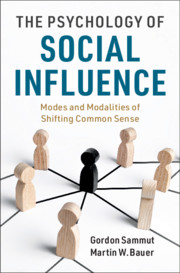Book contents
- The Psychology of Social Influence
- The Psychology of Social Influence
- Copyright page
- Dedication
- Contents
- Figures
- Tables
- Boxes
- Foreword 1
- Foreword 2
- Acknowledgements
- Chapter 1 Modalities of Social Influence
- Part I Recurrent Sources of Populism
- Part II Experimental Paradigms
- Chapter 4 Norming and Framing
- Chapter 5 Conforming and Converting
- Chapter 6 Obeying
- Chapter 7 Persuading and Convincing
- Part III Necessary Extensions
- Part IV Theoretical Integration
- References
- Index
Chapter 4 - Norming and Framing
from Part II - Experimental Paradigms
Published online by Cambridge University Press: 19 December 2020
- The Psychology of Social Influence
- The Psychology of Social Influence
- Copyright page
- Dedication
- Contents
- Figures
- Tables
- Boxes
- Foreword 1
- Foreword 2
- Acknowledgements
- Chapter 1 Modalities of Social Influence
- Part I Recurrent Sources of Populism
- Part II Experimental Paradigms
- Chapter 4 Norming and Framing
- Chapter 5 Conforming and Converting
- Chapter 6 Obeying
- Chapter 7 Persuading and Convincing
- Part III Necessary Extensions
- Part IV Theoretical Integration
- References
- Index
Summary
Chapter 4 examines the modality of norm formation, the processes of establishing a common frame of reference for future collective behaviour. It revisits classical studies in social psychology that have demonstrated how social conditions guide perceptual judgment and decision making. Sherif’s autokinetic experiments and Lewin’s group experiments are reviewed in light of an appraisal of necessary conditions for group processes that foster the emergence of social norms for the coordination of individual conduct. The chapter expands these notions to concepts of intersubjectivity and inter-objectivity. The former requires an interpenetration of views by which individuals are able to consider claims and propositions from the vantage point of another’s perspective. This ability enables the establishment of norms that are objective entities, frame social interactions and make social organisation possible. This process is also illustrated by the stabilisation of a scientific-technical facts of 'objectification'. Symmetrically, the framing of social interaction happens via inter-objectivity, the shared usage of designed hardware and infrastructure of society.
Keywords
- Type
- Chapter
- Information
- The Psychology of Social InfluenceModes and Modalities of Shifting Common Sense, pp. 77 - 96Publisher: Cambridge University PressPrint publication year: 2021

